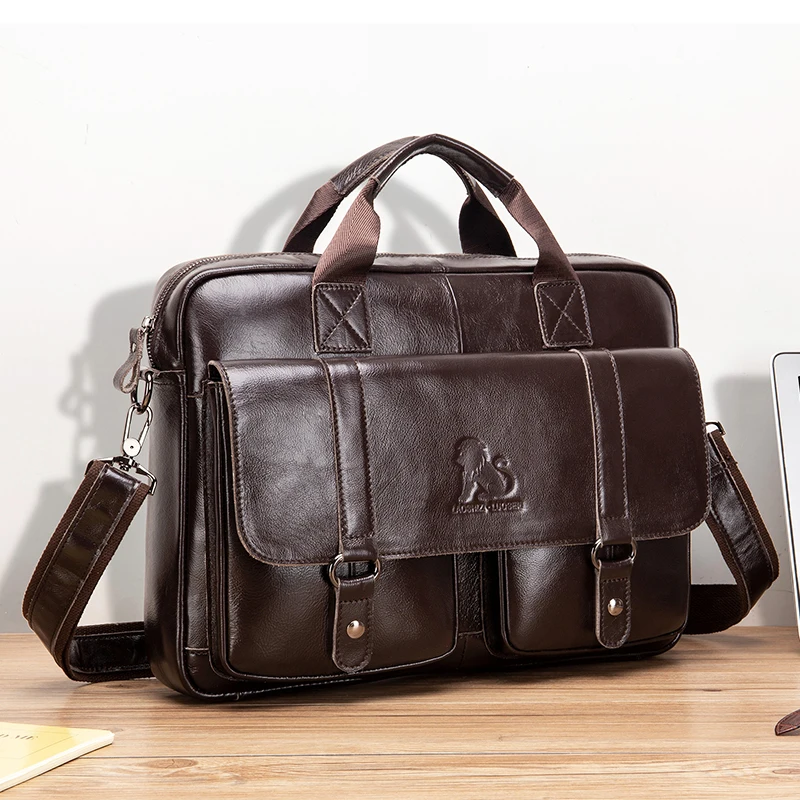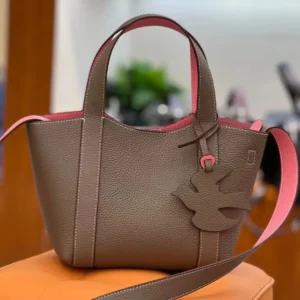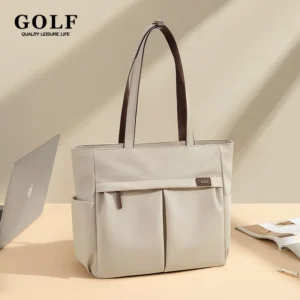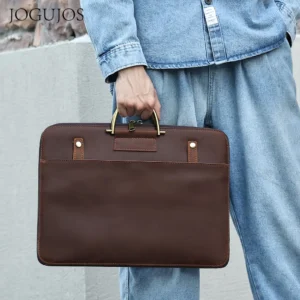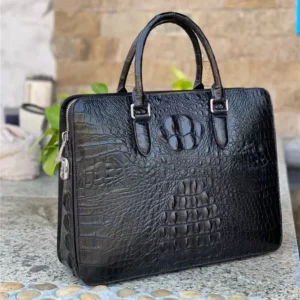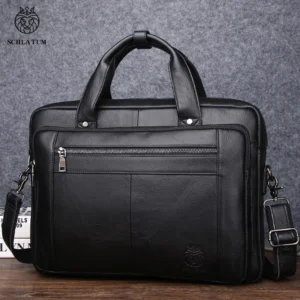In today’s fast-paced professional world, few things can undermine your polished image more quickly than fumbling through a disorganized bag for an important document. We’ve all experienced that moment of panic—rummaging through crumpled papers while a client or colleague waits, only to produce a creased, coffee-stained document that looked pristine when you filed it. A premium leather bag signifies professionalism, but its contents should reflect the same level of care and attention to detail.
This comprehensive guide will walk you through proven strategies for keeping your documents impeccably organized and protected while carried in your leather bag. You’ll discover how thoughtful organization not only preserves your important papers but also extends the life of your leather bag by preventing unnecessary strain on its structure. From essential tools to bag-specific techniques, we’ll cover everything you need to know about document storage tips for leather bags that will keep you organized, efficient, and looking thoroughly professional.
Why Document Organization in Your Leather Bag Matters
Imagine confidently reaching into your bag during an important meeting and immediately retrieving exactly the document you need—no searching, no unfolding, and no apologizing for its condition. This level of preparedness doesn’t just save time; it communicates competence and attention to detail. Every time you smoothly access pristine documents from your leather bag, you reinforce your professional image.
Beyond appearances, proper document organization creates genuine efficiency. The average professional wastes up to 4 hours per week searching for papers—time that could be invested in meaningful work. A well-organized leather bag functions as a mobile command center, allowing you to maximize productivity whether you’re in the office, at a client site, or working from a coffee shop.
Document organization also serves as protection—both for your important papers and for your investment in a quality leather bag. Papers carelessly stuffed into a bag will inevitably become creased, torn, or stained. Meanwhile, the uneven pressure of disorganized contents can distort leather over time, causing premature wear and structural damage. The best briefcases for carrying files are designed with document protection in mind, incorporating features that maintain both document integrity and bag structure.
For professionals who carry sensitive or confidential materials, proper organization also enhances document security by keeping private information neatly contained and properly concealed. Exploring leather document bags specially designed for document transport can provide additional peace of mind through security features like locks or RFID protection.
Assessing Your Document Organization Needs
Before implementing any organization system, take a moment to evaluate your specific document requirements. The perfect system for you will depend on your typical document load, your specific bag’s features, and your personal working style. Understanding these factors will help you develop a tailored approach rather than forcing a generic system that doesn’t address your unique needs.
The essential guide to document-friendly bag interiors provides insights into what makes a bag work well for organizing papers, but first, let’s understand what you’re trying to organize.
Understanding Your Document Types and Volume
Take inventory of the types of documents you regularly carry. A sales executive may primarily transport presentation materials and contracts, while an architect might need to carry large-format drawings and specification sheets. A legal professional likely handles case files with multiple sections that need to remain in precise order.
Consider not just the variety but also the volume of papers you typically carry. Are you managing a handful of critical documents, or do you transport entire project files? Understanding your typical load helps determine whether you need simple folders or more comprehensive organization systems.
Common document categories to consider include:
- Frequently referenced materials (contact lists, pricing sheets)
- Time-sensitive documents (contracts needing signatures, agenda items)
- Presentation materials (handouts, speaking notes)
- Meeting notes and action items
- Reference materials (rarely needed but important to have)
- Personal documents (receipts, business cards)
Evaluating Your Leather Bag’s Organization Features
Your bag’s existing structure will significantly impact your organization strategy. Some leather bags come with built-in document organization features, while others offer more of a blank canvas requiring additional organization tools.
Examine your bag’s interior compartments, pockets, and dividers. A bag with a single large compartment will require different organization solutions than one with multiple divided sections. Consider whether your bag has a dedicated laptop compartment that could double as a document holder, or if it includes specialized slots for folders or portfolios.
The rigidity of your bag also matters—leather briefcase document compartments in structured bags help maintain document shape naturally, while softer bags may require additional stiffeners or document boards to prevent bending. For professionals who prefer a streamlined profile, slim leather briefcases often incorporate clever document organization features that maximize limited space.
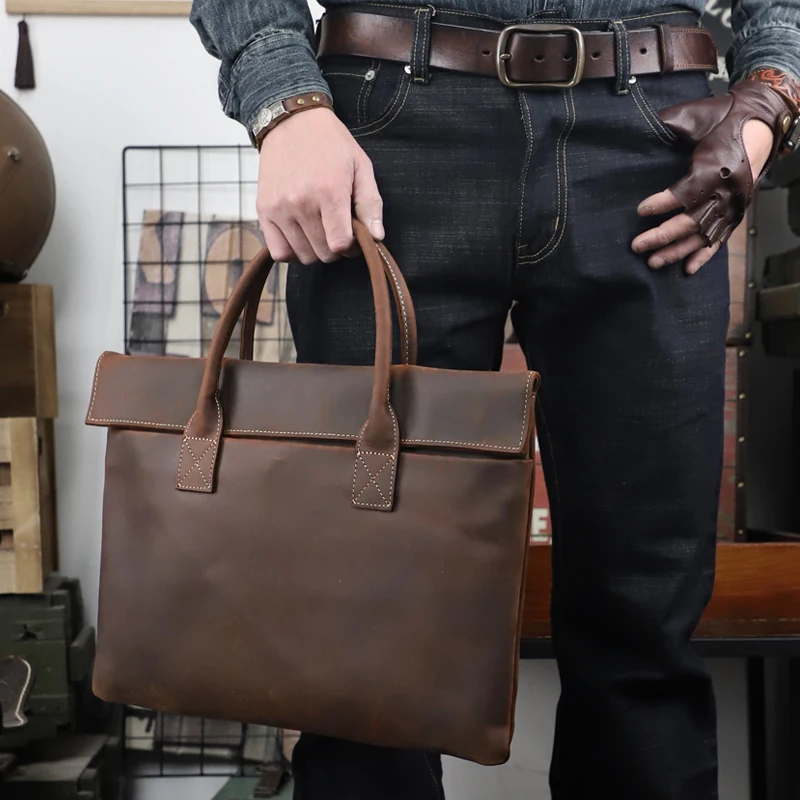
Identifying Your Access Patterns
Understanding how, when, and where you typically access documents will help you design an organization system that works with—rather than against—your natural habits.
Consider these questions to identify your access patterns:
- Do you frequently need to retrieve documents while standing or on the move?
- Are there certain documents you reference multiple times daily?
- Do you primarily add and remove papers throughout the day, or do you mainly carry the same set?
- Do you need to access documents in predictable sequences (like during a presentation)?
- Are you typically working from your bag, or do you unpack at a destination?
A consultant who moves between multiple client meetings may need quick access to different client folders, while a professor might need to keep assignments organized by class. By understanding your specific patterns, you can prioritize accessibility for frequently used items and create a system that reflects your actual workflow.
Essential Organization Tools for Leather Bag Document Management
The right organization tools can transform even the most unstructured leather bag into an efficient document management system. These accessories should complement both the functionality and aesthetics of your leather bag, adding organization without unnecessary bulk or weight.
When selecting organization tools, prioritize slim, lightweight options that won’t strain your bag’s structure or make it uncomfortably heavy to carry. Consider how these tools will interact with your leather bag’s interior—look for smooth edges that won’t scratch or scuff leather linings and materials that won’t transfer color onto your bag’s interior. Mastering document organization and efficient file management begins with selecting the right tools for your specific needs.
Document Folders and Sleeves
Document folders are the foundation of any good organization system, creating physical separation between different types of papers while protecting them from bending and creasing. For leather bags, slim folders are particularly valuable as they add minimal bulk while providing maximum protection.
Clear plastic sleeves offer visibility and protection for frequently referenced single documents. They’re ideal for materials you need to locate quickly without opening multiple folders. For more comprehensive organization, multi-pocket folders allow you to categorize related papers while keeping them contained within a single slim package.
For a cohesive aesthetic, consider investing in a leather portfolio that complements your bag. Many professionals find that a slim leather portfolio briefcase provides both organization and a professional writing surface for meetings—essentially combining document protection with functional workspace.
Look for document folders and sleeves that offer:
* Slim profiles that maximize space efficiency
* Durable materials that resist tearing
* Secure closures that prevent documents from slipping out
* Clear pockets for frequently referenced materials
* Appropriate sizes for your specific documents
Accordion Files and Expanding Organizers
When you need to organize multiple categories of documents while keeping them all accessible, accordion files and expanding organizers provide structured flexibility. These tools feature multiple compartments that expand to accommodate varying document loads while maintaining separation between categories.
Modern expanding organizers designed specifically for professional bags offer significant improvements over traditional office accordion files. Look for compact versions made from lightweight materials with low-profile closures that won’t add unnecessary bulk. Some feature transparent or labeled dividers for quick visual identification of contents without opening each section.
Pros of accordion organizers:
* Create distinct sections for different document categories
* Allow flexible capacity that adapts to changing document loads
* Provide single-unit organization (no loose folders to keep track of)
* Often include labeled tabs for quick reference
Cons to consider:
* Can add more weight than simple folders
* May be bulkier than necessary for minimal document loads
* Lower-quality versions can split at the seams when overfilled
Digital Alternatives and Hybrid Solutions
While physical documents remain essential in many professional contexts, digital alternatives can significantly reduce the paper load in your leather bag. Modern professionals increasingly adopt hybrid approaches that combine the advantages of physical and digital document management.
Document scanning apps turn your smartphone into a portable scanner, allowing you to capture paper documents and store them securely in the cloud. Many of these apps include optical character recognition (OCR) functionality, making the text within your scanned documents searchable—a significant advantage over physical filing systems. For documents you need to reference but don’t need to modify, this approach can dramatically lighten your daily carry.
E-readers and tablets equipped with styluses offer another compelling alternative, allowing you to read, annotate, and share documents electronically. Some digital notebooks even combine the natural feel of writing on paper with automatic cloud backup, giving you the best of both worlds. Mastering mobile office organizing paperwork involves finding the right balance between physical and digital solutions for your specific workflow.
When adopting digital alternatives, consider creating a consistent system that clearly indicates which documents exist in physical form, which are digital-only, and which exist in both formats. This prevents confusion and ensures you can confidently leave certain papers behind.
Core Strategies for Document Organization by Bag Type
Different leather bag styles present unique document organization challenges and opportunities. The internal structure, access patterns, and typical use cases for each bag type require tailored approaches to document organization. By adapting your strategy to your specific bag type, you can maximize protection and accessibility while working with—rather than against—your bag’s natural design.
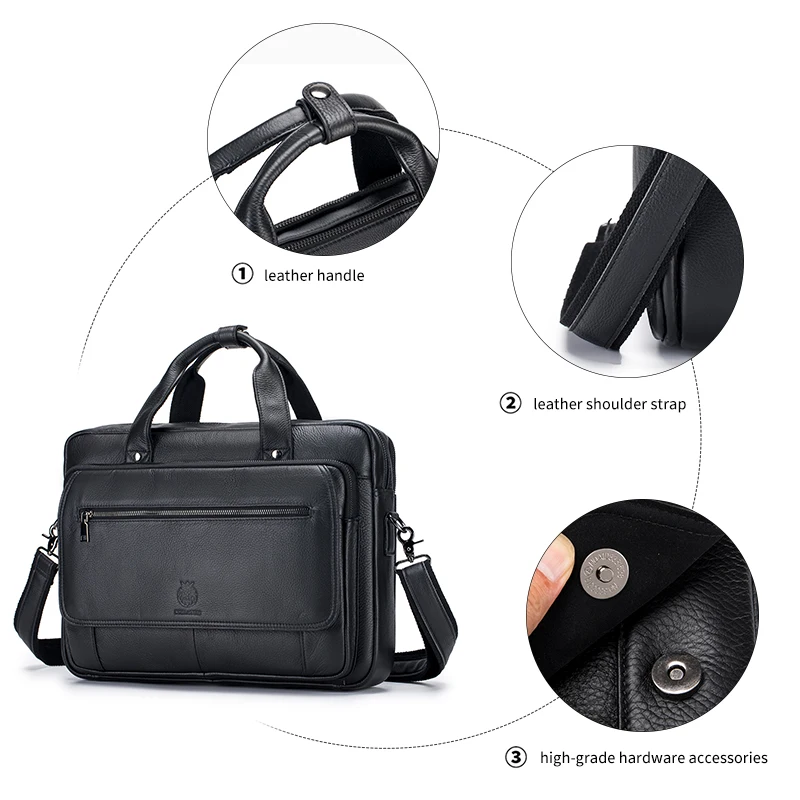
The ultimate guide to leather bags for documents provides comprehensive information on selecting the ideal bag for your document needs, but if you’re working with a bag you already own, these strategies will help you optimize its document organization potential.
Briefcase and Attaché Case Organization
Traditional briefcases and attaché cases offer inherent advantages for document organization thanks to their rigid structure and business-focused design. These bags typically open wide—either from the top or along one side—providing clear visibility and access to contents.
For hinged briefcases that open like a suitcase, utilize both sides strategically. The side that faces up when opened (typically the lid) works well for documents you need to access immediately upon opening the bag. Use slim document folders color-coded by category or priority attached to this side with elastic straps or small clips. The bottom half can accommodate bulkier items or documents that require less frequent access.
For top-loading briefcases with a flap or zipper closure, vertical organization becomes essential. Use stepped file organizers or cascading folders that allow you to see and access multiple document categories without removing everything. Position the most frequently accessed documents toward the front of the bag for easy retrieval.
Tips for optimizing briefcase document organization:
* Use the natural dividers and compartments built into the briefcase design
* Keep frequently accessed documents separate from archival materials
* Utilize the rigidity of the case to support document folders
* Avoid overstuffing, which can strain hinges and clasps
* Consider a classic leather briefcase or slim leather attaché case with built-in document organization features if your current bag lacks them
Leather Messenger Bag Document Solutions
Messenger bags present a different organizational challenge due to their typically softer structure and flap-over design. While this design offers quick access and a casual professional look, it requires thoughtful organization to protect documents from bending and to maintain accessibility.
The key to effective document organization in a messenger bag is creating structure where it doesn’t naturally exist. Consider adding a slim document board or rigid portfolio that spans the full width of the bag’s main compartment. This creates a firm backing that prevents documents from folding when the bag shifts during movement. Position this board against the side that rests against your body for maximum protection.
For messenger bags with multiple internal pockets, designate specific compartments for different document categories. The flat pocket often found at the back of messenger bags works well for documents that should remain flat and accessible. Some professional laptop messenger bags include padded compartments that can double as document protection zones, separating papers from other items that might cause damage.
Tote and Carryall Organization Techniques
Professional leather totes offer spacious interiors but can quickly become document black holes without proper organization. The open-top design and flexible structure of totes create unique challenges for document management.
The most effective approach for tote organization is containment—using smaller organizational units within the larger space. Document portfolios, zippered folders, or sleeve sets keep papers protected and grouped logically within the larger bag. Look for options with handles or tabs that extend slightly above the documents, making them easier to grasp without rummaging.
For totes with minimal internal division, consider a bag-in-bag approach using an insertable document organizer. These structured inserts create dedicated document sections while providing a barrier between papers and other items like water bottles or cosmetics that could cause damage. Many women’s leather business totes and zippered leather work totes now come with thoughtfully designed internal organization that accommodates document storage while maintaining a streamlined external appearance.
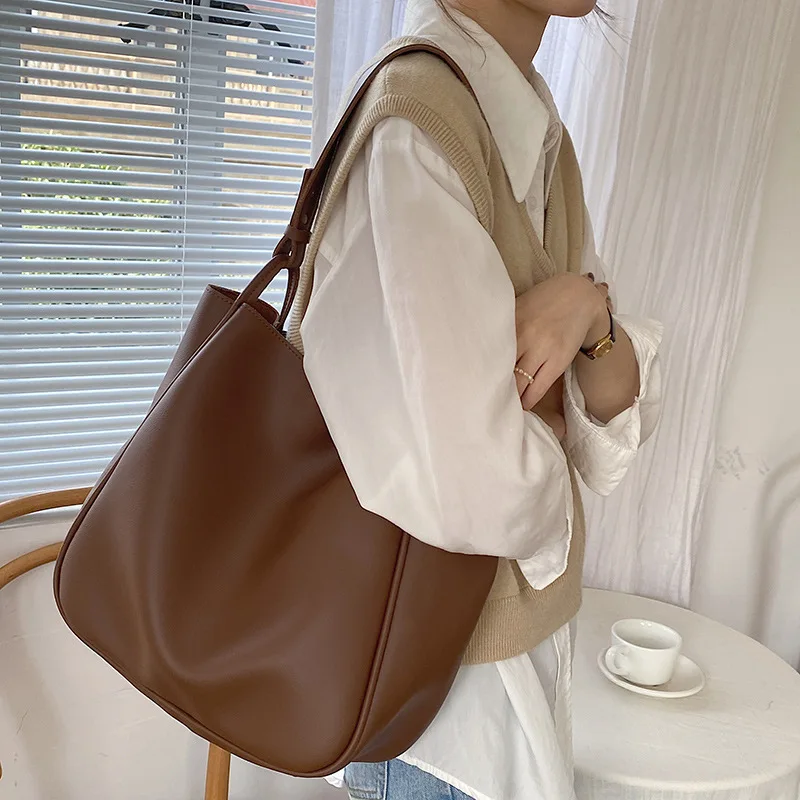
Professional Backpack Document Management
Leather backpacks have gained popularity as professional bags thanks to their comfort and capacity. However, their vertical orientation and loading pattern require specific document organization strategies.
The key challenge with backpacks is preventing documents from sliding to the bottom and becoming crumpled. Secure documents in rigid portfolios positioned against the laptop compartment, which provides natural structure. Many professional backpacks include a document sleeve adjacent to the laptop compartment—utilize this space for papers that must remain pristine.
For backpacks with multiple compartments, establish a consistent location system. Many professionals find it effective to use the outermost compartment for documents needing quick access and the main compartment for more comprehensive file storage. Consider using vertical document organizers that match the natural orientation of the backpack—look for options with top-accessible slots that allow you to retrieve specific documents without removing the entire organizer.
Men's Classic Leather Briefcase, Slim Leather Laptop Briefcase, Slim Leather Portfolio Briefcase
$93.67 Select options This product has multiple variants. The options may be chosen on the product pageBrown Leather Work Tote, Large Leather Work Tote
$194.38 Select options This product has multiple variants. The options may be chosen on the product pageLeather Laptop Work Tote, Tan Leather Work Tote, Women's Leather Work Tote, Zippered Leather Work Tote
Price range: $223.62 through $237.97 Select options This product has multiple variants. The options may be chosen on the product pageClassic Laptop Briefcase, Men's Classic Leather Briefcase, Slim Leather Attache Case
Price range: $353.50 through $360.81 Select options This product has multiple variants. The options may be chosen on the product pageBlack Leather Briefcase, Leather Document Bag, Men's Classic Leather Briefcase
Genuine Crocodile Leather Executive Briefcase with Password Lock – Premium Business Document Carrier$1,201.87 Select options This product has multiple variants. The options may be chosen on the product pageBlack Leather Briefcase, Classic Laptop Briefcase, Men's Classic Leather Briefcase, Slim Leather Laptop Briefcase
$228.72 Select options This product has multiple variants. The options may be chosen on the product page
Document Protection Strategies for Leather Environments
Leather bags present unique considerations for document storage beyond basic organization. The natural properties of leather—including its reaction to moisture, potential for dye transfer, and structural characteristics—require specific document protection strategies that might not be necessary with other bag materials.
Understanding these leather-specific considerations helps you protect both your important papers and your investment in a quality leather bag. The organized leather briefcases for work guide explores how proper document organization contributes to both professional efficiency and bag longevity.
Preventing Dye Transfer and Staining
New leather bags, particularly those with darker colors or vegetable tanning, can sometimes transfer dye to light-colored papers. This risk is highest when the bag is new and gradually diminishes as the leather cures fully. During this breaking-in period, take extra precautions to protect important documents.
The simplest solution is creating a barrier between your documents and the leather. Use neutral-colored document sleeves or folders rather than placing loose papers directly against the leather interior. If your bag has a fabric lining, this provides some protection, but additional barriers are still recommended for important documents.
Beyond dye transfer from the leather itself, consider the other items typically carried in your bag. Pens can leak, especially under pressure or with temperature changes in flight. Keep writing instruments in a dedicated pen case rather than loose in the bag, and position this case away from important documents. Similarly, separate water bottles or travel mugs from document storage areas with waterproof dividers.
Moisture Protection in Leather Environments
Leather has a complex relationship with moisture. While quality leather goods typically receive water-resistant treatment during manufacturing, no leather is completely waterproof. Additionally, leather can absorb humidity from the environment, potentially transferring that moisture to paper documents.
Waterproof document sleeves provide effective protection for papers that must remain pristine regardless of conditions. For professionals who commute or travel frequently, these sleeves offer peace of mind during unexpected rain showers or spills. The professional guide to urban commuting with leather bags provides additional strategies for protecting both your bag and its contents during daily travels.
Create isolation zones within your bag for items that pose moisture risks. Water bottles, umbrellas, and even certain electronics that heat up during use should be separated from document storage areas. Many premium leather bags include dedicated water bottle pockets or waterproof compartments specifically designed for this purpose.
Maintaining Document and Bag Structure
Proper document organization does more than keep your papers accessible—it helps preserve the structure of your leather bag. Overstuffing or uneven loading places stress on the leather, potentially leading to stretched handles, distorted shapes, or damaged seams over time.
Rigid document organizers distribute weight evenly throughout the bag, preventing pressure points that could distort the leather. If your bag begins to bulge in certain areas when packed with documents, consider reorganizing with slimmer folders or removing non-essential papers.
Pay attention to weight distribution, particularly for bags carried by handles or on one shoulder. Position heavier document sets toward the back of the bag (the side that rests against your body) to reduce strain on handles and improve carrying comfort. The professionals’ guide to leather bag care provides additional insights on maintaining your bag’s appearance and structural integrity.
Advanced Organization Systems for Professional Excellence
Once you’ve mastered basic document organization, you may find yourself ready for more sophisticated systems that further enhance your efficiency and professionalism. These advanced approaches are particularly valuable for professionals who manage complex document ecosystems involving multiple projects, clients, or workflows.
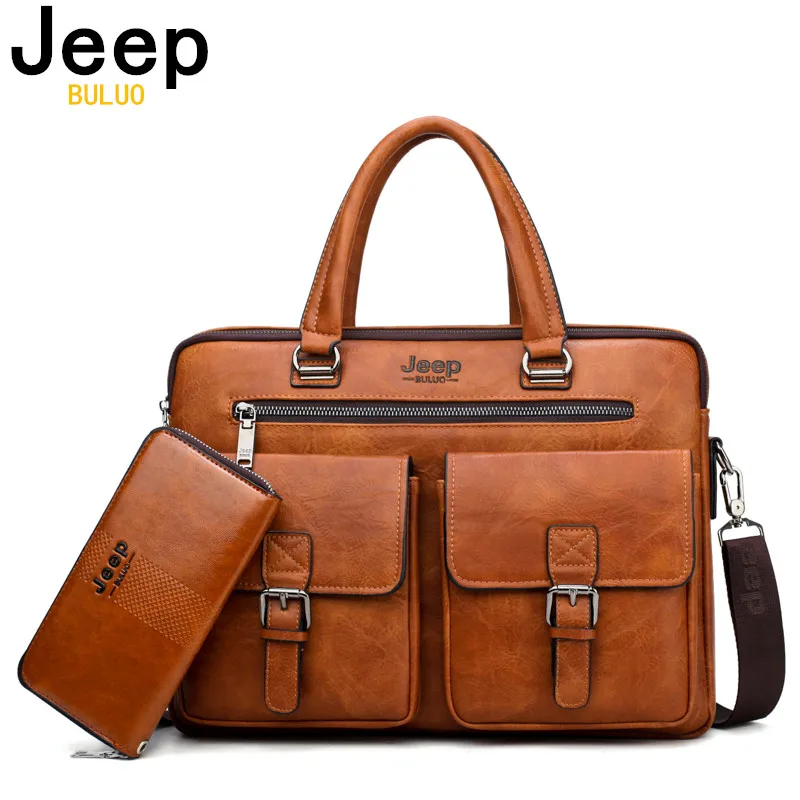
Color-Coding and Visual Organization Systems
Visual organization systems allow you to identify document categories at a glance, significantly reducing the time spent searching for specific papers. A thoughtfully implemented color system creates an intuitive interface for your document collection, making organization almost automatic over time.
The most effective color systems are simple and consistent. Assign specific colors to broad categories that remain relatively stable—client types, project phases, or document purposes rather than individual projects that change frequently. For example, red folders might contain time-sensitive documents requiring immediate action, blue for client-facing materials, green for internal reference documents, and so forth.
Look for color-coding tools specifically designed for professional settings. Subtle colored tabs, edge markers, or slim colored folders present a more refined appearance than bright plastic office supplies. When creating your system, consider how these colors will look in a professional setting—opt for sophisticated tones rather than primary colors when possible.
Project and Client-Based Organization
For professionals who manage multiple clients or projects simultaneously, creating dedicated zones for each one prevents cross-contamination of materials and allows for quick context-switching between different work streams.
Consider implementing a portable version of the classic “project box” concept. Slim document wallets in consistent sizes—one per project or client—create clear boundaries between different work contexts while maintaining a cohesive system. These can be color-coded by client type or project status for additional visual organization.
For managing document versions and updates, establish a consistent notation system that travels with the documents. Simple methods include corner dots indicating version numbers or small tab markers showing review status. Mastering leather bags with multiple sections provides strategies for utilizing bag compartments to separate different projects while maintaining accessibility.
Integration with Digital Workflow
Modern professionals rarely work exclusively with either physical or digital documents—most navigate a hybrid environment where information flows between paper and digital formats. Creating intentional connections between these worlds enhances organization and reduces duplication.
Consider adding QR codes to physical document folders that link to corresponding digital project spaces or cloud folders. When you need to reference additional materials not carried in your bag, a quick scan provides access to the extended document ecosystem. Similarly, cover sheets with project summaries can include links to relevant digital resources, creating a bridge between your physical and digital workflows.
Some document management apps allow you to photograph physical documents and instantly organize them within your digital system. This approach enables you to carry minimal paper while maintaining access to your complete document collection. When you capture a document digitally, consider adding a small checkmark or notation on the physical copy to indicate it has a digital backup, preventing unnecessary retention of duplicate materials.
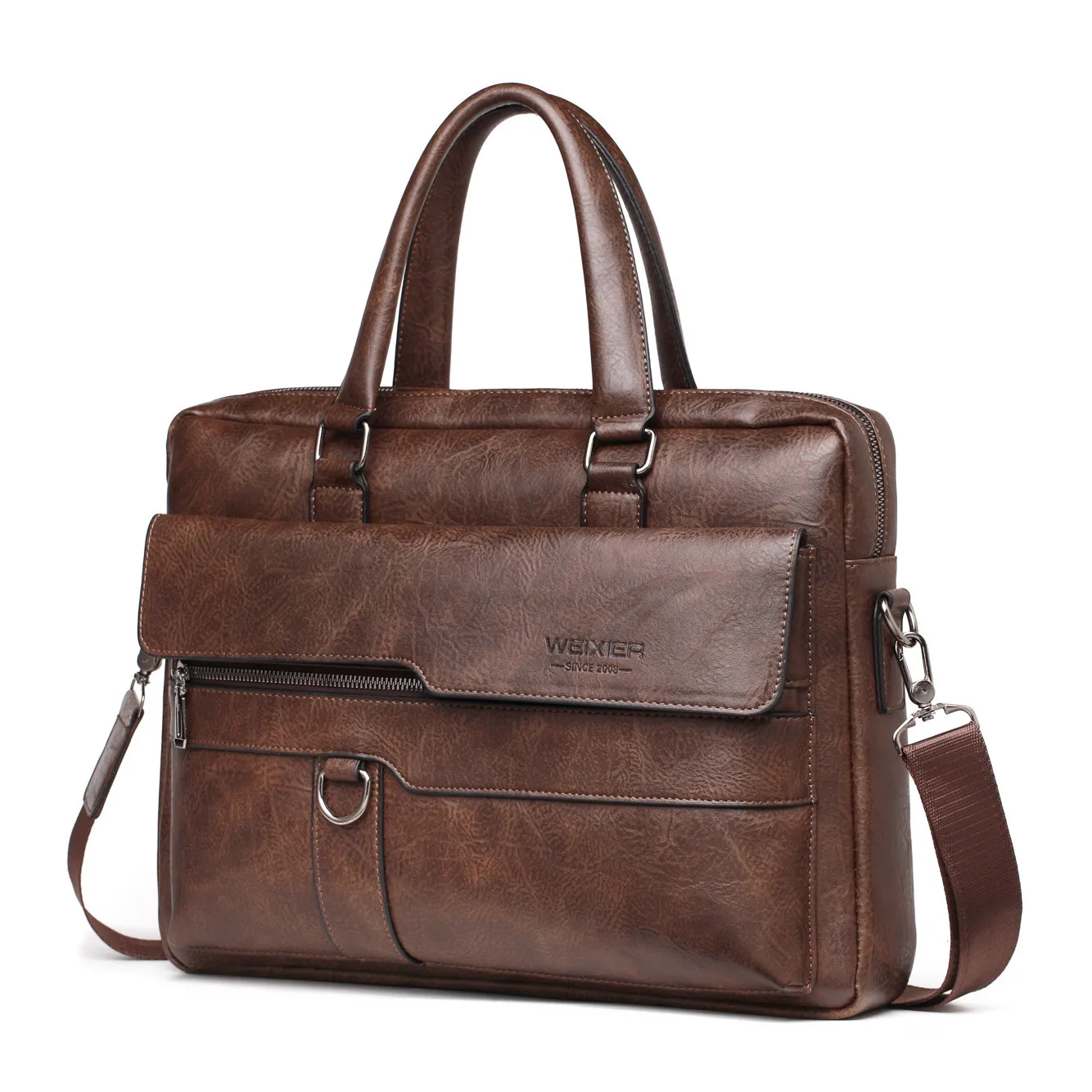
Maintaining Your Organized System
Even the most thoughtfully designed document organization system will deteriorate without regular maintenance. The key to sustained organization is incorporating small, consistent habits into your routine rather than relying on occasional major reorganization efforts.
Daily Quick-Organization Routine
End each workday with a brief reset of your leather bag’s contents. This simple five-minute routine prevents the gradual slide into disorganization and ensures you start each day prepared and efficient.
A effective daily routine includes:
* Removing unnecessary papers that don’t need to remain in your bag
* Returning documents to their designated locations immediately after use
* Sorting any new documents received during the day into appropriate categories
* Placing high-priority documents for tomorrow in an easily accessible location
* Ensuring all folders and organizers are properly closed and secured
This daily maintenance prevents the accumulation of loose papers and ensures that your organization system remains functional rather than becoming another layer of complexity.
Weekly Document Audit and Reset
Dedicate 15 minutes each week to a more thorough review of your bag’s contents. This weekly audit catches organizational drift before it becomes problematic and gives you an opportunity to adapt your system as your needs evolve.
During your weekly reset:
* Remove all document organizers from your bag and review their contents
* Relocate any documents that no longer need to be carried daily
* File or scan documents that should be archived rather than transported
* Assess whether your current categories still reflect your workflow
* Clean any dust or debris from the bag’s interior
* Check that organizing tools remain in good condition
Many professionals find Friday afternoon an ideal time for this weekly reset, allowing them to process the week’s accumulated documents and prepare a clean system for the coming week.
Adapting Your System as Needs Change
The perfect organization system isn’t static—it evolves alongside your professional responsibilities and document requirements. Pay attention to signs that your current system might need adjustment, such as frequently searching for specific documents, carrying papers you rarely use, or feeling that your bag is unnecessarily heavy.
Be particularly attentive to system needs during professional transitions. Taking on new clients, beginning new projects, or changing roles often requires corresponding adjustments to your document organization approach. Similarly, seasonal changes in workload—such as tax preparation periods or end-of-year reporting—might necessitate temporary modifications to accommodate additional paperwork.
When evaluating new organization tools or approaches, consider both their immediate utility and their compatibility with your existing system. The most sustainable organizational improvements build upon what’s working rather than requiring complete reinvention.
Troubleshooting Common Document Organization Challenges
Even with the best organization systems, specific challenges inevitably arise. These practical solutions address common document organization problems that professionals encounter with leather bags.
The large vs. slim briefcase guide can help determine if your current bag size suits your document carrying needs, but these solutions work with whatever bag you currently use.
Dealing with Oversized Documents
Legal-sized documents, large presentation materials, and architectural drawings present particular challenges for standard leather bags. When you occasionally need to transport oversized documents without creasing or folding them, consider these approaches:
For documents slightly larger than your bag’s interior, rigid document sleeves with extending flaps provide protection while allowing a portion of the document to extend beyond the bag’s dimensions. Position these oversized documents against the flattest side of your bag to minimize bending.
When folding is unavoidable, use professional folding techniques that minimize creasing. For important documents, fold along areas with minimal text or images, and create soft folds rather than sharp creases. Once you arrive at your destination, remove and flatten these documents immediately to prevent permanent creasing.
For professionals who regularly work with oversized materials, consider a large leather work tote specifically designed to accommodate these larger formats while maintaining a professional appearance.
Managing Frequent Document Additions and Removals
For professionals who continuously add and remove documents throughout the day, maintaining organization can be particularly challenging. Creating a staging system prevents your carefully organized bag from becoming chaotic by midday.
Designate a specific “in/out” folder or envelope as a temporary holding area for documents in transition. This creates a single location for new papers acquired during the day, preventing them from being haphazardly tucked into random spaces in your bag. During your daily organization routine, sort these accumulated documents into their proper locations.
For documents that will be referenced multiple times throughout the day, consider a front-positioned quick-access folder. This prevents repeated disruption of your main organization system while keeping frequently used documents readily available.
When Space Is at a Premium
Compact leather bags require particularly thoughtful document organization. When space constraints limit your options, prioritization becomes essential.
Begin by critically evaluating which documents truly need to be physically present. Could some reference materials be accessed digitally instead? For documents that must be carried, consider using thinner folders or removing documents from bulky presentation binders while in transit.
Compression techniques can significantly reduce document bulk without causing damage. Use slim document wallets rather than traditional folders, and select organization tools with minimal structural elements. Some modern document sleeves use air-displacement designs that reduce thickness while maintaining protection.
Miniaturization can also help—consider printing important reference documents in a condensed format or on both sides of the paper to reduce overall volume. For documents used primarily for reference, scaled-down printouts in a compact reference booklet can replace full-sized pages.
Is Your Leather Bag Suited to Your Document Needs?
While organization strategies can significantly improve document management within any leather bag, sometimes the bag itself might not be ideally suited to your specific document requirements. Periodically assess whether your current bag supports or hinders your organization efforts.
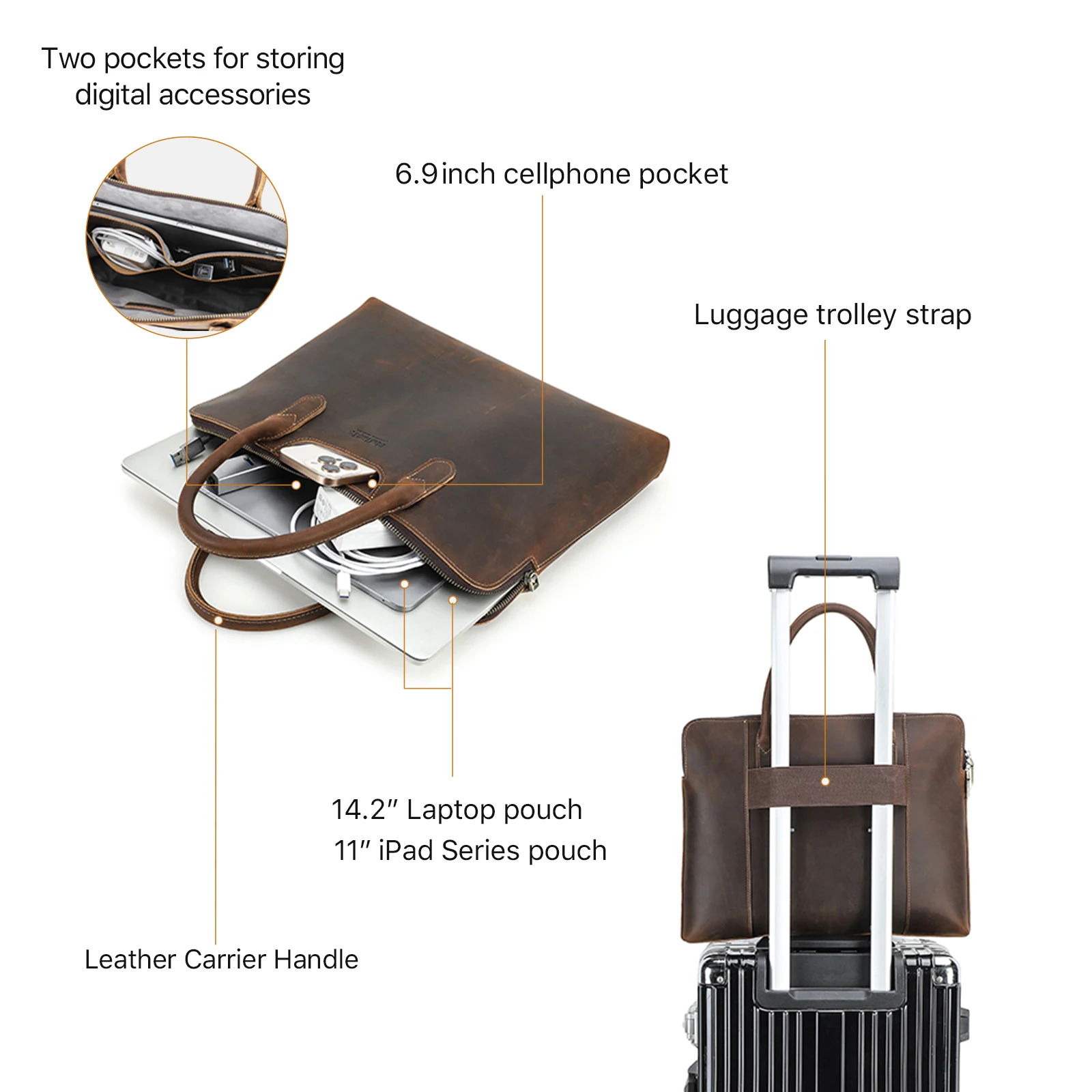
Questions to Evaluate Your Bag’s Document Compatibility
Consider these questions to determine if your current bag meets your document organization needs:
- Do you consistently struggle to fit your essential documents, even with optimal organization?
- Are your documents frequently damaged despite your best protection efforts?
- Does your bag lack internal structure, causing documents to bend or fold?
- Do you find yourself avoiding carrying certain important documents because your bag can’t accommodate them properly?
- Does organizing your bag require excessive accessories that add significant weight?
- Has your document load changed significantly since you purchased your bag?
If you answered yes to several of these questions, your current bag might not be optimally suited to your document needs. This doesn’t necessarily mean replacing your bag—sometimes adding a complementary smaller document bag for specific situations can address these challenges.
Key Features That Enhance Document Organization
If you’re considering a bag that better supports your document organization needs, look for these document-friendly features:
Premium leather bags from Poise Porter are designed with document organization in mind, incorporating many of these features while maintaining sophisticated aesthetics. Classic laptop briefcases often provide an excellent balance of document organization features and technology accommodation.
- Built-in document dividers that create natural separation
- Padded compartments that protect papers from bending
- Water-resistant interior linings that shield contents from moisture
- Structured sides that maintain shape even when not full
- Thoughtfully positioned interior pockets that prevent document migration
- Accessible but secure closure systems that prevent papers from falling out
- Interior straps or fasteners to secure document folders in place
- Proportions that accommodate standard document sizes without excess bulk
FAQ: Document Organization in Leather Bags
How do I prevent papers from getting bent in a soft leather bag?
Soft leather bags require additional structure to protect documents from bending. Insert a slim document board or rigid portfolio that spans the width of your bag’s main compartment, creating a firm backing for your papers. Position this board against the side that rests against your body when carrying the bag.
For individual documents that must remain pristine, use rigid document sleeves with reinforced edges rather than flexible folders. When possible, position documents in the center of your bag rather than at the edges where bending is more likely to occur as the bag conforms to your body’s movement.
What’s the best way to organize receipts in a leather bag?
Receipts present a unique organization challenge due to their varying sizes and thermal paper that can fade over time. A dedicated receipt wallet with multiple compartments allows you to categorize receipts while keeping them contained in a single compact location.
For business professionals who need to track expenses, consider a two-stage approach: carry a small receipt envelope in an accessible pocket for immediate collection, then transfer and organize these receipts during your weekly reset. Some professionals find it effective to photograph receipts immediately with expense-tracking apps, allowing them to discard many paper receipts while maintaining digital records.
Can I use standard office folders in a leather bag without damaging it?
Standard office folders can potentially damage leather bag interiors due to their rigid plastic edges, metal fasteners, and sometimes rough surfaces. These elements can scratch delicate leather linings or create pressure points that distort the bag’s structure over time.
Instead, look for folders specifically designed for transport—these typically feature rounded corners, smooth exteriors, and flexible but protective materials. If you must use standard office supplies, modify them by rounding sharp corners and covering any metal fasteners with protective tabs. When possible, place standard folders inside a smooth leather portfolio or document sleeve to create a buffer between these items and your bag’s interior.
By implementing these organization strategies and selecting appropriate tools, you’ll transform your leather bag into an efficient, professional document management system. Beyond simply knowing where everything is, proper document organization protects your important papers, preserves your premium leather bag, and projects the polished image that quality leather goods are meant to convey.

